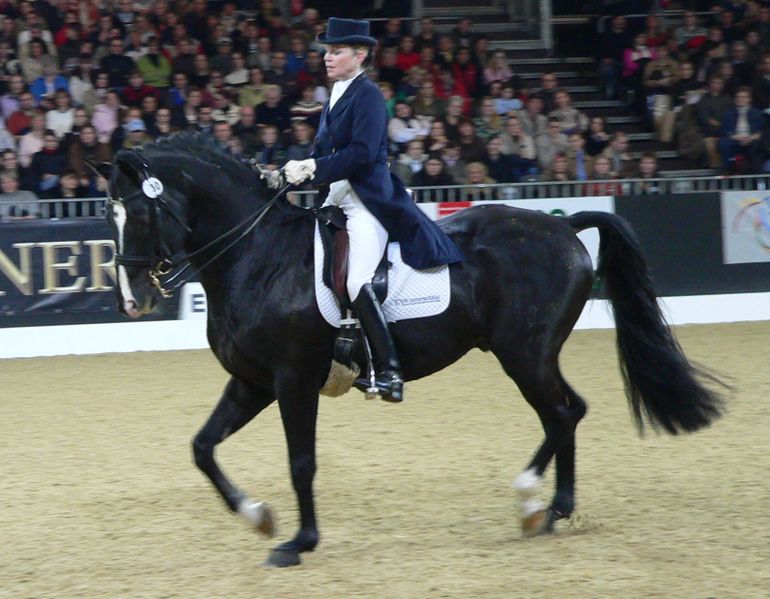Horse colors
Horses have coats in shades of black, red, white, brown and grey, and mane and tail colors that either match, or contrast, with color of the coat. Those colors lend a distinctive appearance to the individual horse, and sometimes, typify an entire horse breed. The genetics behind the inheritance of these colors is a fascinating subject in and of itself, but is also of practical interest to the horse breeder and owner. Knowlege of colors and markings are important in identifying horses and in breeding selection for desireable traits. Not only are some colors and patterns in increased demand, but sometimes these features are written in to the breed standard of purbred horses. The Paint horse, and the Appaloosa, for example, were originally defined largely for the pattern of their coats. The Lipizzaner horses, famous as the "dancing white stallions" are (like almost all "white" horses) almost always grey. Speculation about just how color and pattern is inherited in horses has probably been around as long as horse breeding has been, but it is only in the last decades that an understanding of the genetics has become sophisticated enough to go beyond speculation. Several DNA tests for color genes are now available, and a blood or hair root sample can reveal the genotype of a mare and stallion, allowing the breeder to predict the appearance of their offspring. Since some of those genes also influence eye and skin color, and the color of hoofs, as well as the patterns of color on the coat and the probability of white markings like socks, snipes, and blazes, accuracy of that prediction can go beyond simple base coat color.
Solid colors
Chestnut and sorrel
Black or bay? : the agouti gene
Bay
Blood bay
When a bay horse has a particularly red coat, the name "blood bay" is often used.
Black
When a horse with black coat pigment is doubly recessive for the Agouti gene, pigment is spread evenly over each hair and the apearance is black rather than bay. Since a single copy of the dominant allele of an Agouti gene will make that horse bay, and there are two agouti genes in each horse, overall, black horses are unusual. When breeds of horses, like the draft horse XXX are characteristically black, both parents will carry a pair of recessive ag genes, and their foals will share their color. Fresians, a particularly elegant draft breed, are almost always black, for this reason.
True black or barn black?
Smoky black
Grey horses
Most horses called "white" are actually grey. The gene responsible for this color is actually responsible for a process, "greying". Grey foals are born a different color than they will have as young horses, and that color will usually change over time, becoming lighter and lighter.
In youth, many grey horses have lighter coats than manes and tails, and may have a black mane and tail through much of their adult life.
Grey horses have a dominant form of the G gene, which excludes pigment from hair.
White or true albino horses: the W gene
If a horse possesses the dominant allele W, it will, starting from birth, lack pigment in both skin and hair. The skin is pink and the hair white. The eyes brown are usually brown, but can be blue. This horse is called white, or sometimes, albino. The W allele is rare. All horses that are homozygous for the recessive pigment allele are ww, and those horses include every one of the other colors discussed in this article. In other words, all non-white (meaning non-albino) horses are ww.
Roan horses
Dilution genes: The creme gene
Unlike many other mammals, horses are that are albino are not simply unusual, but unhealthy. When a horse has light eyes and pink skin, along with a light coat the gene at work is a dilution gene, rather than some form of lethal white. [1]. The creme gene codes for a modification of color, in its dominant form, CR, there is no modification. A heterozygous recessive, CR/cr, will lighten coat color and a doubly recessive creme gene, cr/cr will doubly lighten it. The resulting color will depend on the base color of the horse and other factors, as outlined below.
Buckskin
Dilution of a bay horse results in buckskin coloration. This horse will have at least one copy of the dominant agouti gene, AG, so that black pigment on the coat is relegated to the mane, tail and points. A well-marked buckskin horse has a tan body, black mane and tail, and black "socks".
There are additional modifications to the body coat color that are known by the colloquial terms "smutty buckskin", "sooty buckskin" and "black buckskin", when a percentage of body hairs are entirely dark.
Grulla
Smoky black
Dilution of a black horse results in smoky black coloration. Such a horse, like all black horses, will be doubly recessive for the agouti allele (ag, ag) and black pigment will be evenly spread along each hair.
Palomino
A chestnut horse (also caled sorrel) with a single dilute gene yields a palomino horse. Like the buckskin, there can be additional modifications of coat color. A so-called "chocolate palomino" occurs when XXX. The Paso fino Tomaria's Gallardo is an example of a chocolate or smutty palomino.
Cremello
This horse has a cream-colored coat that can range from a rather deep cream to near white. It is a doubly dilute form of a chestnut horse, and will have pink skin and blue eyes.
Perlino
Another double dilute, the perlino XXX
Paint or pinto patterns
Medicine hat
Overo
Tobiano
Blue-eyed horses
Genetic testing
Various laboratories around the world offer genetic testing of horses on either a research or commercial basis. The University of California at Davis [2] Vetinary Genetics Laboratory is one such facility. It's website is linked in the preceding sentence because of its site clear explanation of the tests and of horse color genetics.
